Energy Efficiency in Hospitals: A Case Study of Victoria, Australia
VerifiedAdded on 2021/04/21
|11
|2316
|460
Report
AI Summary
This report delves into the critical topic of energy efficiency within Australian hospitals, presenting a detailed analysis of the current state and potential improvements. The study begins by establishing the significance of energy consumption in healthcare facilities and their substantial carbon footprint. The research then poses key questions regarding energy-efficient improvements and their benefits. A comprehensive literature review explores existing research on energy-saving strategies, including HVAC systems, renewable energy sources, and building design. The methodology section outlines a qualitative Grounded theory approach, employing purposive sampling of hospitals in Queensland, Australia, and data collection through interviews. The data analysis involves coding, constant comparison, memoing, and theorizing to develop a robust understanding of the research topic. The report also includes a detailed work schedule, providing a timeline for the research process. The findings of this research will offer valuable insights for hospitals to improve energy efficiency.
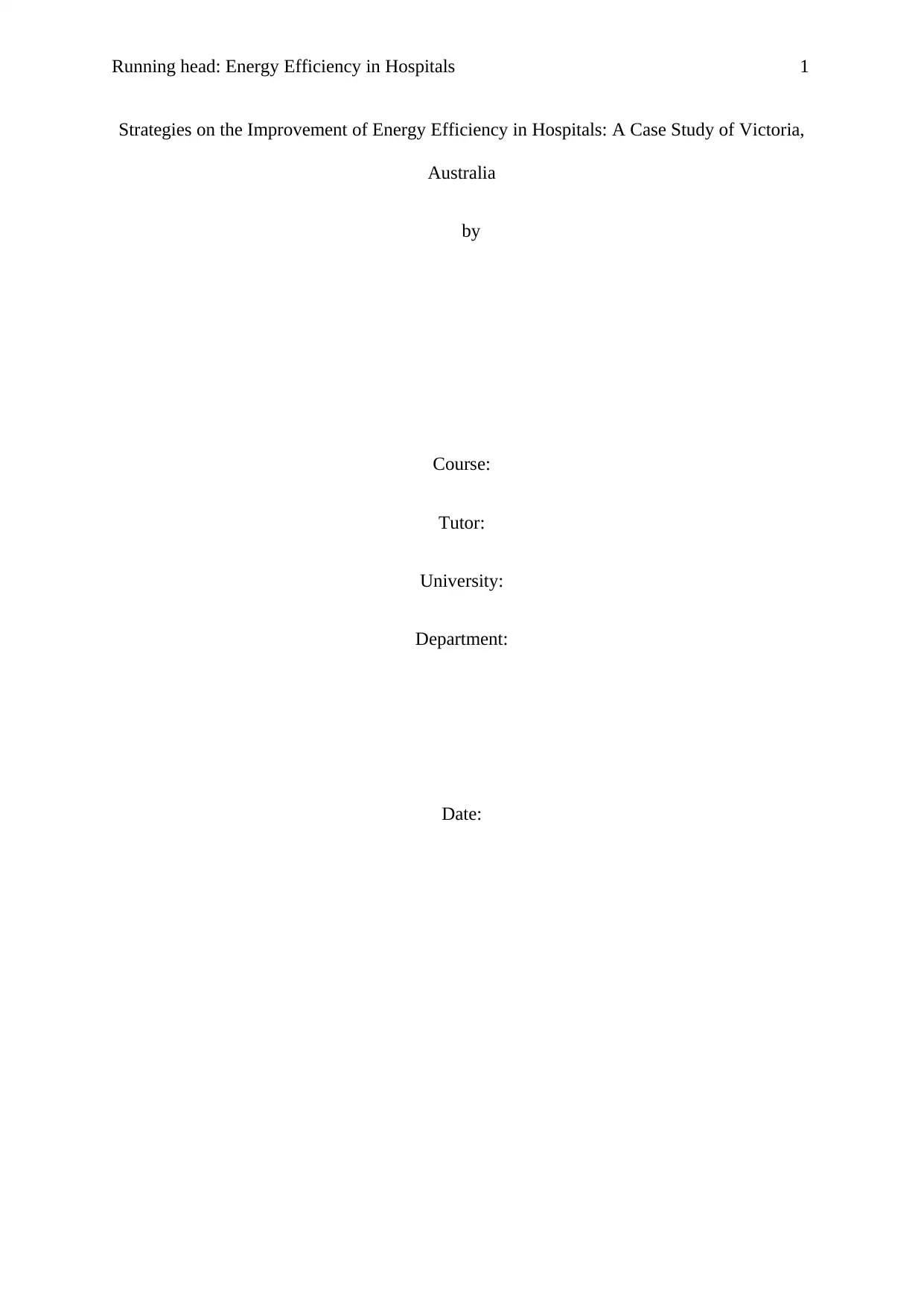
Running head: Energy Efficiency in Hospitals 1
Strategies on the Improvement of Energy Efficiency in Hospitals: A Case Study of Victoria,
Australia
by
Course:
Tutor:
University:
Department:
Date:
Strategies on the Improvement of Energy Efficiency in Hospitals: A Case Study of Victoria,
Australia
by
Course:
Tutor:
University:
Department:
Date:
Paraphrase This Document
Need a fresh take? Get an instant paraphrase of this document with our AI Paraphraser
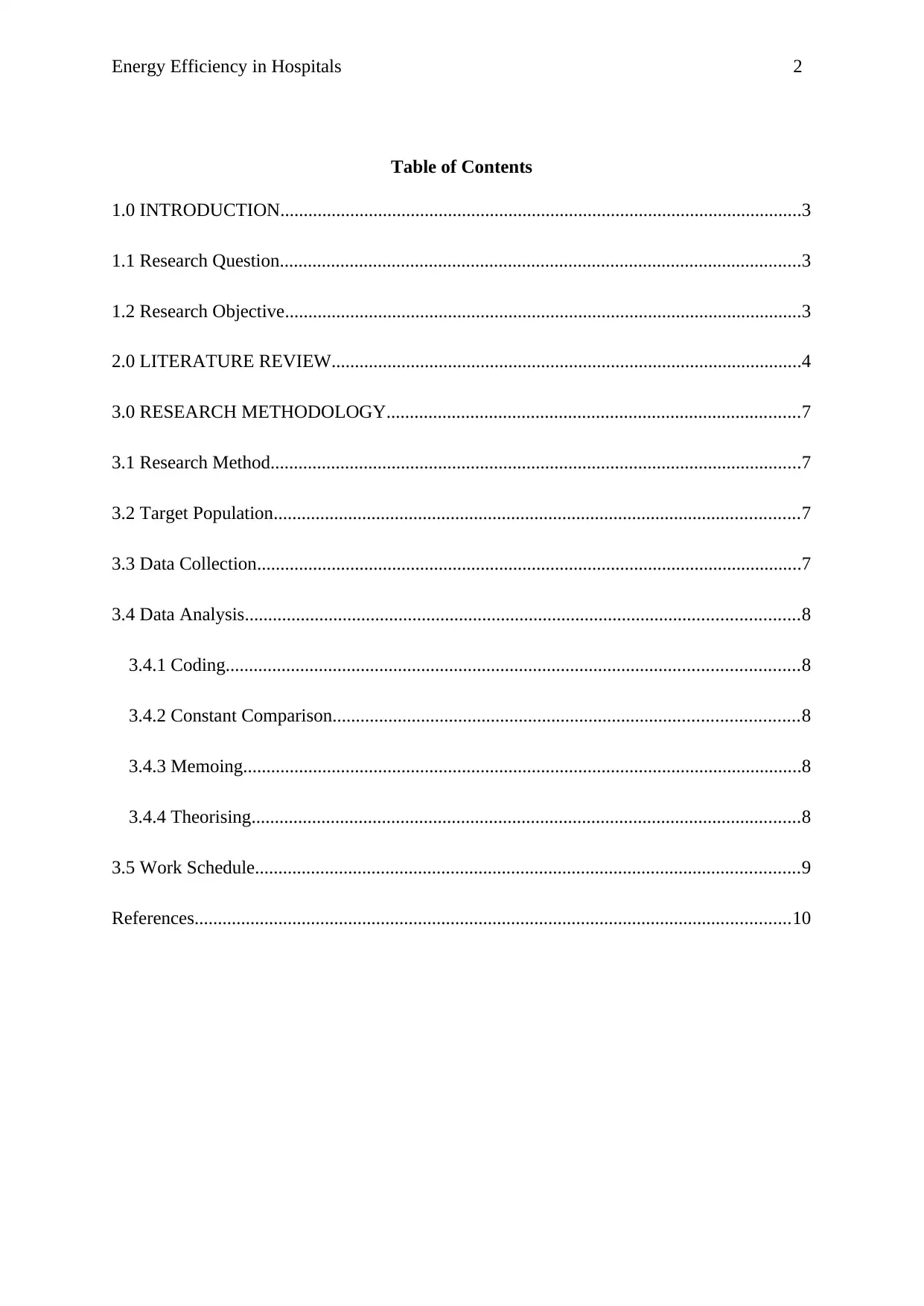
Energy Efficiency in Hospitals 2
Table of Contents
1.0 INTRODUCTION................................................................................................................3
1.1 Research Question................................................................................................................3
1.2 Research Objective...............................................................................................................3
2.0 LITERATURE REVIEW.....................................................................................................4
3.0 RESEARCH METHODOLOGY.........................................................................................7
3.1 Research Method..................................................................................................................7
3.2 Target Population.................................................................................................................7
3.3 Data Collection.....................................................................................................................7
3.4 Data Analysis.......................................................................................................................8
3.4.1 Coding...........................................................................................................................8
3.4.2 Constant Comparison....................................................................................................8
3.4.3 Memoing........................................................................................................................8
3.4.4 Theorising......................................................................................................................8
3.5 Work Schedule.....................................................................................................................9
References................................................................................................................................10
Table of Contents
1.0 INTRODUCTION................................................................................................................3
1.1 Research Question................................................................................................................3
1.2 Research Objective...............................................................................................................3
2.0 LITERATURE REVIEW.....................................................................................................4
3.0 RESEARCH METHODOLOGY.........................................................................................7
3.1 Research Method..................................................................................................................7
3.2 Target Population.................................................................................................................7
3.3 Data Collection.....................................................................................................................7
3.4 Data Analysis.......................................................................................................................8
3.4.1 Coding...........................................................................................................................8
3.4.2 Constant Comparison....................................................................................................8
3.4.3 Memoing........................................................................................................................8
3.4.4 Theorising......................................................................................................................8
3.5 Work Schedule.....................................................................................................................9
References................................................................................................................................10
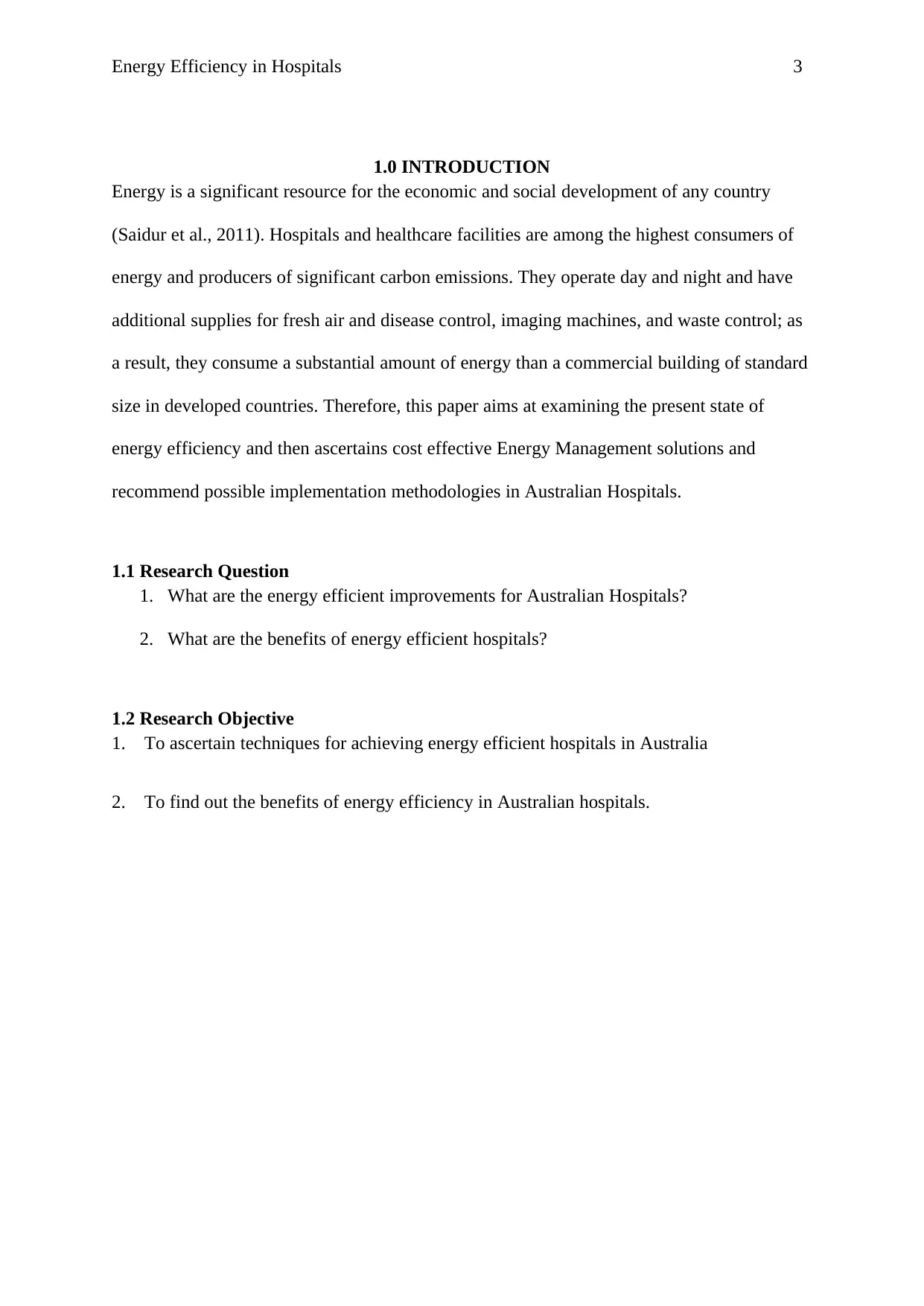
Energy Efficiency in Hospitals 3
1.0 INTRODUCTION
Energy is a significant resource for the economic and social development of any country
(Saidur et al., 2011). Hospitals and healthcare facilities are among the highest consumers of
energy and producers of significant carbon emissions. They operate day and night and have
additional supplies for fresh air and disease control, imaging machines, and waste control; as
a result, they consume a substantial amount of energy than a commercial building of standard
size in developed countries. Therefore, this paper aims at examining the present state of
energy efficiency and then ascertains cost effective Energy Management solutions and
recommend possible implementation methodologies in Australian Hospitals.
1.1 Research Question
1. What are the energy efficient improvements for Australian Hospitals?
2. What are the benefits of energy efficient hospitals?
1.2 Research Objective
1. To ascertain techniques for achieving energy efficient hospitals in Australia
2. To find out the benefits of energy efficiency in Australian hospitals.
1.0 INTRODUCTION
Energy is a significant resource for the economic and social development of any country
(Saidur et al., 2011). Hospitals and healthcare facilities are among the highest consumers of
energy and producers of significant carbon emissions. They operate day and night and have
additional supplies for fresh air and disease control, imaging machines, and waste control; as
a result, they consume a substantial amount of energy than a commercial building of standard
size in developed countries. Therefore, this paper aims at examining the present state of
energy efficiency and then ascertains cost effective Energy Management solutions and
recommend possible implementation methodologies in Australian Hospitals.
1.1 Research Question
1. What are the energy efficient improvements for Australian Hospitals?
2. What are the benefits of energy efficient hospitals?
1.2 Research Objective
1. To ascertain techniques for achieving energy efficient hospitals in Australia
2. To find out the benefits of energy efficiency in Australian hospitals.
⊘ This is a preview!⊘
Do you want full access?
Subscribe today to unlock all pages.

Trusted by 1+ million students worldwide
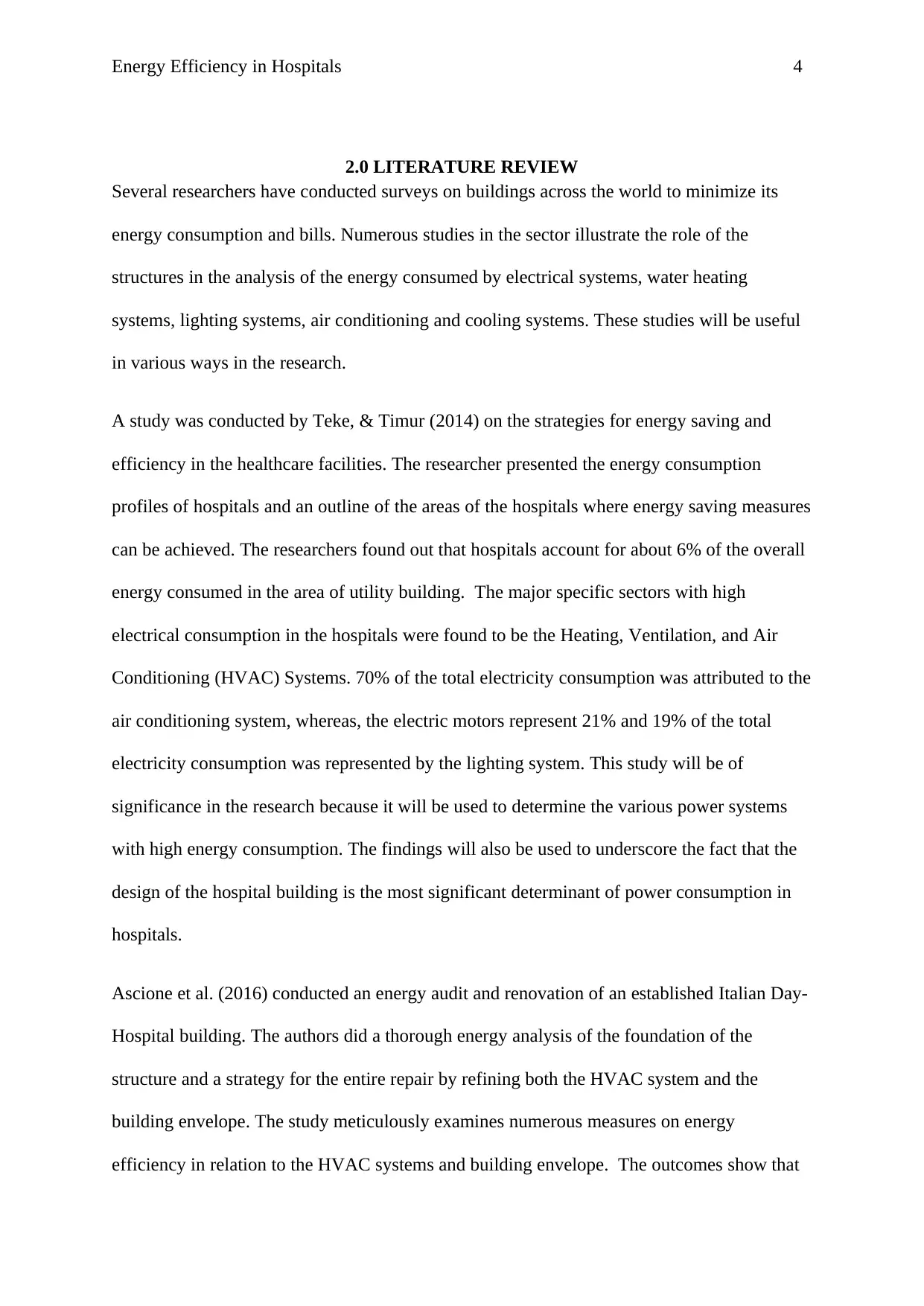
Energy Efficiency in Hospitals 4
2.0 LITERATURE REVIEW
Several researchers have conducted surveys on buildings across the world to minimize its
energy consumption and bills. Numerous studies in the sector illustrate the role of the
structures in the analysis of the energy consumed by electrical systems, water heating
systems, lighting systems, air conditioning and cooling systems. These studies will be useful
in various ways in the research.
A study was conducted by Teke, & Timur (2014) on the strategies for energy saving and
efficiency in the healthcare facilities. The researcher presented the energy consumption
profiles of hospitals and an outline of the areas of the hospitals where energy saving measures
can be achieved. The researchers found out that hospitals account for about 6% of the overall
energy consumed in the area of utility building. The major specific sectors with high
electrical consumption in the hospitals were found to be the Heating, Ventilation, and Air
Conditioning (HVAC) Systems. 70% of the total electricity consumption was attributed to the
air conditioning system, whereas, the electric motors represent 21% and 19% of the total
electricity consumption was represented by the lighting system. This study will be of
significance in the research because it will be used to determine the various power systems
with high energy consumption. The findings will also be used to underscore the fact that the
design of the hospital building is the most significant determinant of power consumption in
hospitals.
Ascione et al. (2016) conducted an energy audit and renovation of an established Italian Day-
Hospital building. The authors did a thorough energy analysis of the foundation of the
structure and a strategy for the entire repair by refining both the HVAC system and the
building envelope. The study meticulously examines numerous measures on energy
efficiency in relation to the HVAC systems and building envelope. The outcomes show that
2.0 LITERATURE REVIEW
Several researchers have conducted surveys on buildings across the world to minimize its
energy consumption and bills. Numerous studies in the sector illustrate the role of the
structures in the analysis of the energy consumed by electrical systems, water heating
systems, lighting systems, air conditioning and cooling systems. These studies will be useful
in various ways in the research.
A study was conducted by Teke, & Timur (2014) on the strategies for energy saving and
efficiency in the healthcare facilities. The researcher presented the energy consumption
profiles of hospitals and an outline of the areas of the hospitals where energy saving measures
can be achieved. The researchers found out that hospitals account for about 6% of the overall
energy consumed in the area of utility building. The major specific sectors with high
electrical consumption in the hospitals were found to be the Heating, Ventilation, and Air
Conditioning (HVAC) Systems. 70% of the total electricity consumption was attributed to the
air conditioning system, whereas, the electric motors represent 21% and 19% of the total
electricity consumption was represented by the lighting system. This study will be of
significance in the research because it will be used to determine the various power systems
with high energy consumption. The findings will also be used to underscore the fact that the
design of the hospital building is the most significant determinant of power consumption in
hospitals.
Ascione et al. (2016) conducted an energy audit and renovation of an established Italian Day-
Hospital building. The authors did a thorough energy analysis of the foundation of the
structure and a strategy for the entire repair by refining both the HVAC system and the
building envelope. The study meticulously examines numerous measures on energy
efficiency in relation to the HVAC systems and building envelope. The outcomes show that
Paraphrase This Document
Need a fresh take? Get an instant paraphrase of this document with our AI Paraphraser
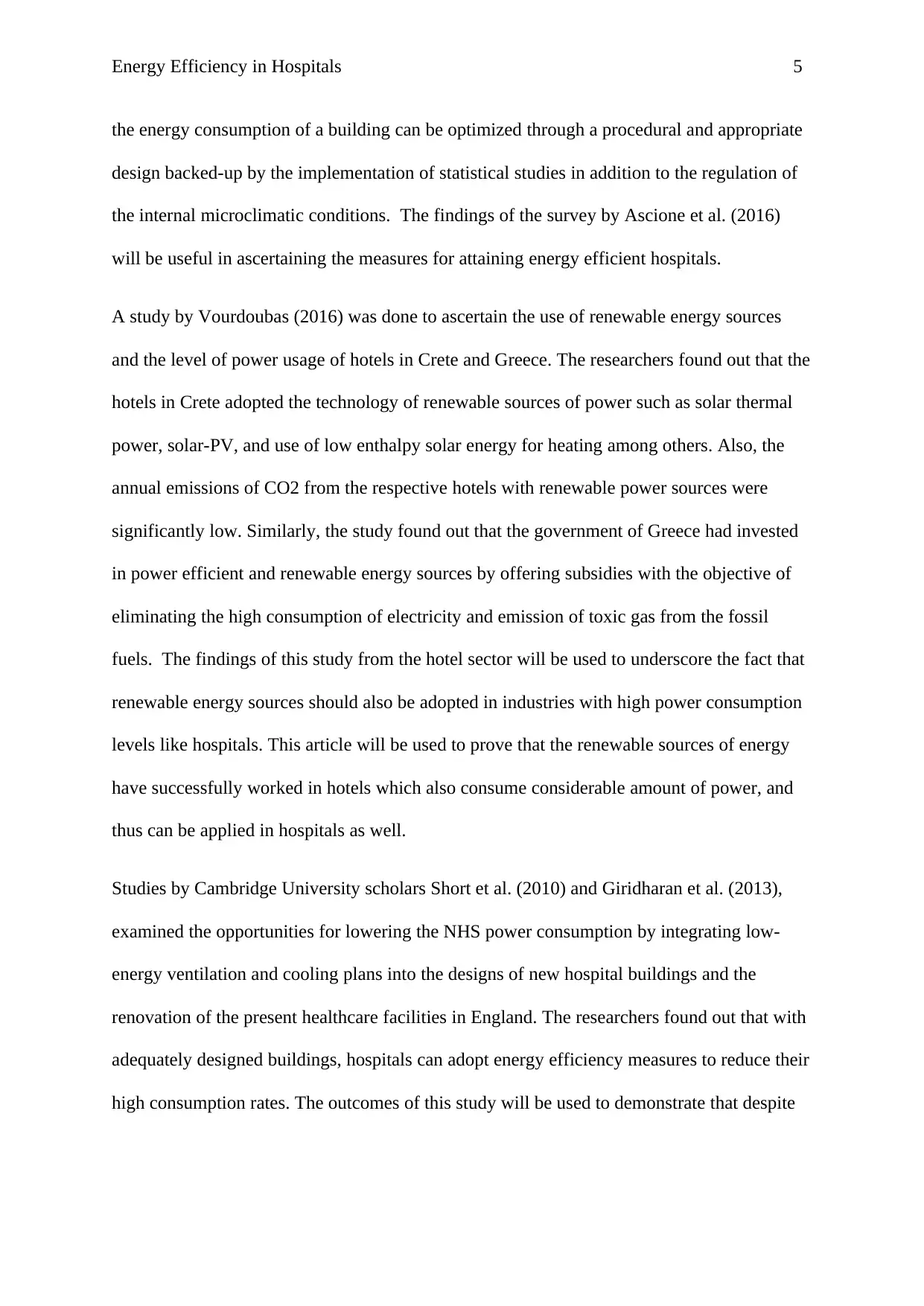
Energy Efficiency in Hospitals 5
the energy consumption of a building can be optimized through a procedural and appropriate
design backed-up by the implementation of statistical studies in addition to the regulation of
the internal microclimatic conditions. The findings of the survey by Ascione et al. (2016)
will be useful in ascertaining the measures for attaining energy efficient hospitals.
A study by Vourdoubas (2016) was done to ascertain the use of renewable energy sources
and the level of power usage of hotels in Crete and Greece. The researchers found out that the
hotels in Crete adopted the technology of renewable sources of power such as solar thermal
power, solar-PV, and use of low enthalpy solar energy for heating among others. Also, the
annual emissions of CO2 from the respective hotels with renewable power sources were
significantly low. Similarly, the study found out that the government of Greece had invested
in power efficient and renewable energy sources by offering subsidies with the objective of
eliminating the high consumption of electricity and emission of toxic gas from the fossil
fuels. The findings of this study from the hotel sector will be used to underscore the fact that
renewable energy sources should also be adopted in industries with high power consumption
levels like hospitals. This article will be used to prove that the renewable sources of energy
have successfully worked in hotels which also consume considerable amount of power, and
thus can be applied in hospitals as well.
Studies by Cambridge University scholars Short et al. (2010) and Giridharan et al. (2013),
examined the opportunities for lowering the NHS power consumption by integrating low-
energy ventilation and cooling plans into the designs of new hospital buildings and the
renovation of the present healthcare facilities in England. The researchers found out that with
adequately designed buildings, hospitals can adopt energy efficiency measures to reduce their
high consumption rates. The outcomes of this study will be used to demonstrate that despite
the energy consumption of a building can be optimized through a procedural and appropriate
design backed-up by the implementation of statistical studies in addition to the regulation of
the internal microclimatic conditions. The findings of the survey by Ascione et al. (2016)
will be useful in ascertaining the measures for attaining energy efficient hospitals.
A study by Vourdoubas (2016) was done to ascertain the use of renewable energy sources
and the level of power usage of hotels in Crete and Greece. The researchers found out that the
hotels in Crete adopted the technology of renewable sources of power such as solar thermal
power, solar-PV, and use of low enthalpy solar energy for heating among others. Also, the
annual emissions of CO2 from the respective hotels with renewable power sources were
significantly low. Similarly, the study found out that the government of Greece had invested
in power efficient and renewable energy sources by offering subsidies with the objective of
eliminating the high consumption of electricity and emission of toxic gas from the fossil
fuels. The findings of this study from the hotel sector will be used to underscore the fact that
renewable energy sources should also be adopted in industries with high power consumption
levels like hospitals. This article will be used to prove that the renewable sources of energy
have successfully worked in hotels which also consume considerable amount of power, and
thus can be applied in hospitals as well.
Studies by Cambridge University scholars Short et al. (2010) and Giridharan et al. (2013),
examined the opportunities for lowering the NHS power consumption by integrating low-
energy ventilation and cooling plans into the designs of new hospital buildings and the
renovation of the present healthcare facilities in England. The researchers found out that with
adequately designed buildings, hospitals can adopt energy efficiency measures to reduce their
high consumption rates. The outcomes of this study will be used to demonstrate that despite
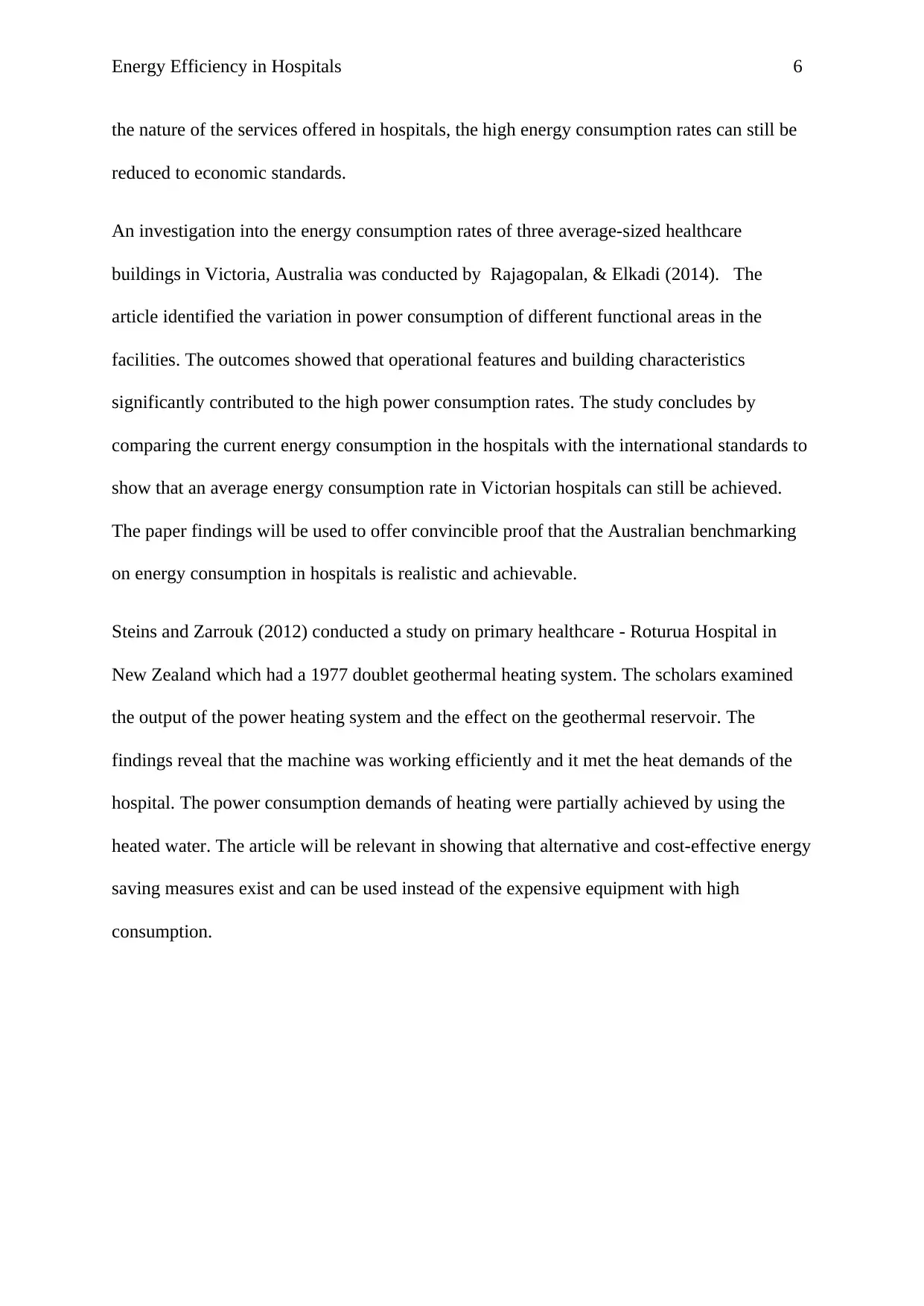
Energy Efficiency in Hospitals 6
the nature of the services offered in hospitals, the high energy consumption rates can still be
reduced to economic standards.
An investigation into the energy consumption rates of three average-sized healthcare
buildings in Victoria, Australia was conducted by Rajagopalan, & Elkadi (2014). The
article identified the variation in power consumption of different functional areas in the
facilities. The outcomes showed that operational features and building characteristics
significantly contributed to the high power consumption rates. The study concludes by
comparing the current energy consumption in the hospitals with the international standards to
show that an average energy consumption rate in Victorian hospitals can still be achieved.
The paper findings will be used to offer convincible proof that the Australian benchmarking
on energy consumption in hospitals is realistic and achievable.
Steins and Zarrouk (2012) conducted a study on primary healthcare - Roturua Hospital in
New Zealand which had a 1977 doublet geothermal heating system. The scholars examined
the output of the power heating system and the effect on the geothermal reservoir. The
findings reveal that the machine was working efficiently and it met the heat demands of the
hospital. The power consumption demands of heating were partially achieved by using the
heated water. The article will be relevant in showing that alternative and cost-effective energy
saving measures exist and can be used instead of the expensive equipment with high
consumption.
the nature of the services offered in hospitals, the high energy consumption rates can still be
reduced to economic standards.
An investigation into the energy consumption rates of three average-sized healthcare
buildings in Victoria, Australia was conducted by Rajagopalan, & Elkadi (2014). The
article identified the variation in power consumption of different functional areas in the
facilities. The outcomes showed that operational features and building characteristics
significantly contributed to the high power consumption rates. The study concludes by
comparing the current energy consumption in the hospitals with the international standards to
show that an average energy consumption rate in Victorian hospitals can still be achieved.
The paper findings will be used to offer convincible proof that the Australian benchmarking
on energy consumption in hospitals is realistic and achievable.
Steins and Zarrouk (2012) conducted a study on primary healthcare - Roturua Hospital in
New Zealand which had a 1977 doublet geothermal heating system. The scholars examined
the output of the power heating system and the effect on the geothermal reservoir. The
findings reveal that the machine was working efficiently and it met the heat demands of the
hospital. The power consumption demands of heating were partially achieved by using the
heated water. The article will be relevant in showing that alternative and cost-effective energy
saving measures exist and can be used instead of the expensive equipment with high
consumption.
⊘ This is a preview!⊘
Do you want full access?
Subscribe today to unlock all pages.

Trusted by 1+ million students worldwide
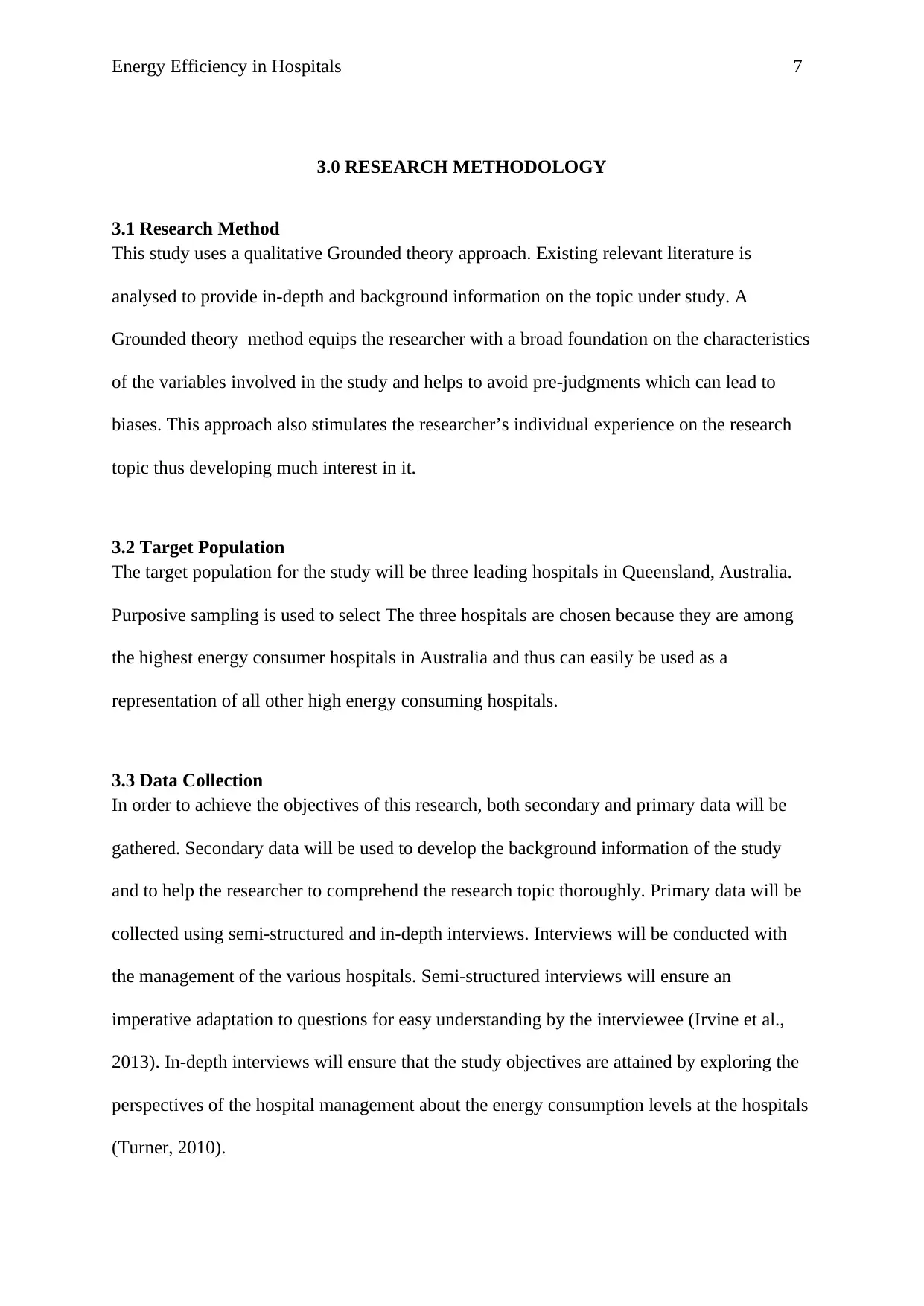
Energy Efficiency in Hospitals 7
3.0 RESEARCH METHODOLOGY
3.1 Research Method
This study uses a qualitative Grounded theory approach. Existing relevant literature is
analysed to provide in-depth and background information on the topic under study. A
Grounded theory method equips the researcher with a broad foundation on the characteristics
of the variables involved in the study and helps to avoid pre-judgments which can lead to
biases. This approach also stimulates the researcher’s individual experience on the research
topic thus developing much interest in it.
3.2 Target Population
The target population for the study will be three leading hospitals in Queensland, Australia.
Purposive sampling is used to select The three hospitals are chosen because they are among
the highest energy consumer hospitals in Australia and thus can easily be used as a
representation of all other high energy consuming hospitals.
3.3 Data Collection
In order to achieve the objectives of this research, both secondary and primary data will be
gathered. Secondary data will be used to develop the background information of the study
and to help the researcher to comprehend the research topic thoroughly. Primary data will be
collected using semi-structured and in-depth interviews. Interviews will be conducted with
the management of the various hospitals. Semi-structured interviews will ensure an
imperative adaptation to questions for easy understanding by the interviewee (Irvine et al.,
2013). In-depth interviews will ensure that the study objectives are attained by exploring the
perspectives of the hospital management about the energy consumption levels at the hospitals
(Turner, 2010).
3.0 RESEARCH METHODOLOGY
3.1 Research Method
This study uses a qualitative Grounded theory approach. Existing relevant literature is
analysed to provide in-depth and background information on the topic under study. A
Grounded theory method equips the researcher with a broad foundation on the characteristics
of the variables involved in the study and helps to avoid pre-judgments which can lead to
biases. This approach also stimulates the researcher’s individual experience on the research
topic thus developing much interest in it.
3.2 Target Population
The target population for the study will be three leading hospitals in Queensland, Australia.
Purposive sampling is used to select The three hospitals are chosen because they are among
the highest energy consumer hospitals in Australia and thus can easily be used as a
representation of all other high energy consuming hospitals.
3.3 Data Collection
In order to achieve the objectives of this research, both secondary and primary data will be
gathered. Secondary data will be used to develop the background information of the study
and to help the researcher to comprehend the research topic thoroughly. Primary data will be
collected using semi-structured and in-depth interviews. Interviews will be conducted with
the management of the various hospitals. Semi-structured interviews will ensure an
imperative adaptation to questions for easy understanding by the interviewee (Irvine et al.,
2013). In-depth interviews will ensure that the study objectives are attained by exploring the
perspectives of the hospital management about the energy consumption levels at the hospitals
(Turner, 2010).
Paraphrase This Document
Need a fresh take? Get an instant paraphrase of this document with our AI Paraphraser
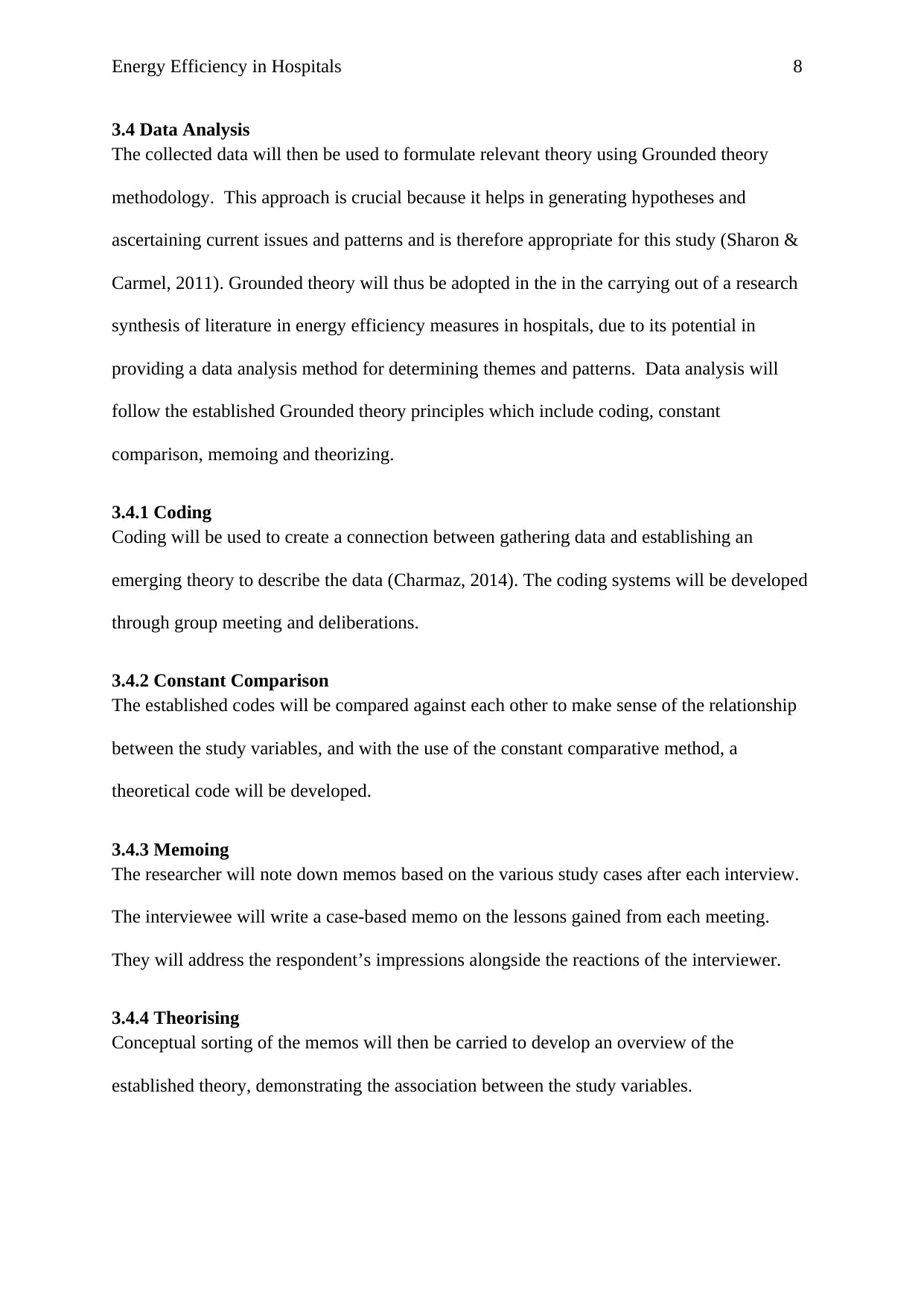
Energy Efficiency in Hospitals 8
3.4 Data Analysis
The collected data will then be used to formulate relevant theory using Grounded theory
methodology. This approach is crucial because it helps in generating hypotheses and
ascertaining current issues and patterns and is therefore appropriate for this study (Sharon &
Carmel, 2011). Grounded theory will thus be adopted in the in the carrying out of a research
synthesis of literature in energy efficiency measures in hospitals, due to its potential in
providing a data analysis method for determining themes and patterns. Data analysis will
follow the established Grounded theory principles which include coding, constant
comparison, memoing and theorizing.
3.4.1 Coding
Coding will be used to create a connection between gathering data and establishing an
emerging theory to describe the data (Charmaz, 2014). The coding systems will be developed
through group meeting and deliberations.
3.4.2 Constant Comparison
The established codes will be compared against each other to make sense of the relationship
between the study variables, and with the use of the constant comparative method, a
theoretical code will be developed.
3.4.3 Memoing
The researcher will note down memos based on the various study cases after each interview.
The interviewee will write a case-based memo on the lessons gained from each meeting.
They will address the respondent’s impressions alongside the reactions of the interviewer.
3.4.4 Theorising
Conceptual sorting of the memos will then be carried to develop an overview of the
established theory, demonstrating the association between the study variables.
3.4 Data Analysis
The collected data will then be used to formulate relevant theory using Grounded theory
methodology. This approach is crucial because it helps in generating hypotheses and
ascertaining current issues and patterns and is therefore appropriate for this study (Sharon &
Carmel, 2011). Grounded theory will thus be adopted in the in the carrying out of a research
synthesis of literature in energy efficiency measures in hospitals, due to its potential in
providing a data analysis method for determining themes and patterns. Data analysis will
follow the established Grounded theory principles which include coding, constant
comparison, memoing and theorizing.
3.4.1 Coding
Coding will be used to create a connection between gathering data and establishing an
emerging theory to describe the data (Charmaz, 2014). The coding systems will be developed
through group meeting and deliberations.
3.4.2 Constant Comparison
The established codes will be compared against each other to make sense of the relationship
between the study variables, and with the use of the constant comparative method, a
theoretical code will be developed.
3.4.3 Memoing
The researcher will note down memos based on the various study cases after each interview.
The interviewee will write a case-based memo on the lessons gained from each meeting.
They will address the respondent’s impressions alongside the reactions of the interviewer.
3.4.4 Theorising
Conceptual sorting of the memos will then be carried to develop an overview of the
established theory, demonstrating the association between the study variables.
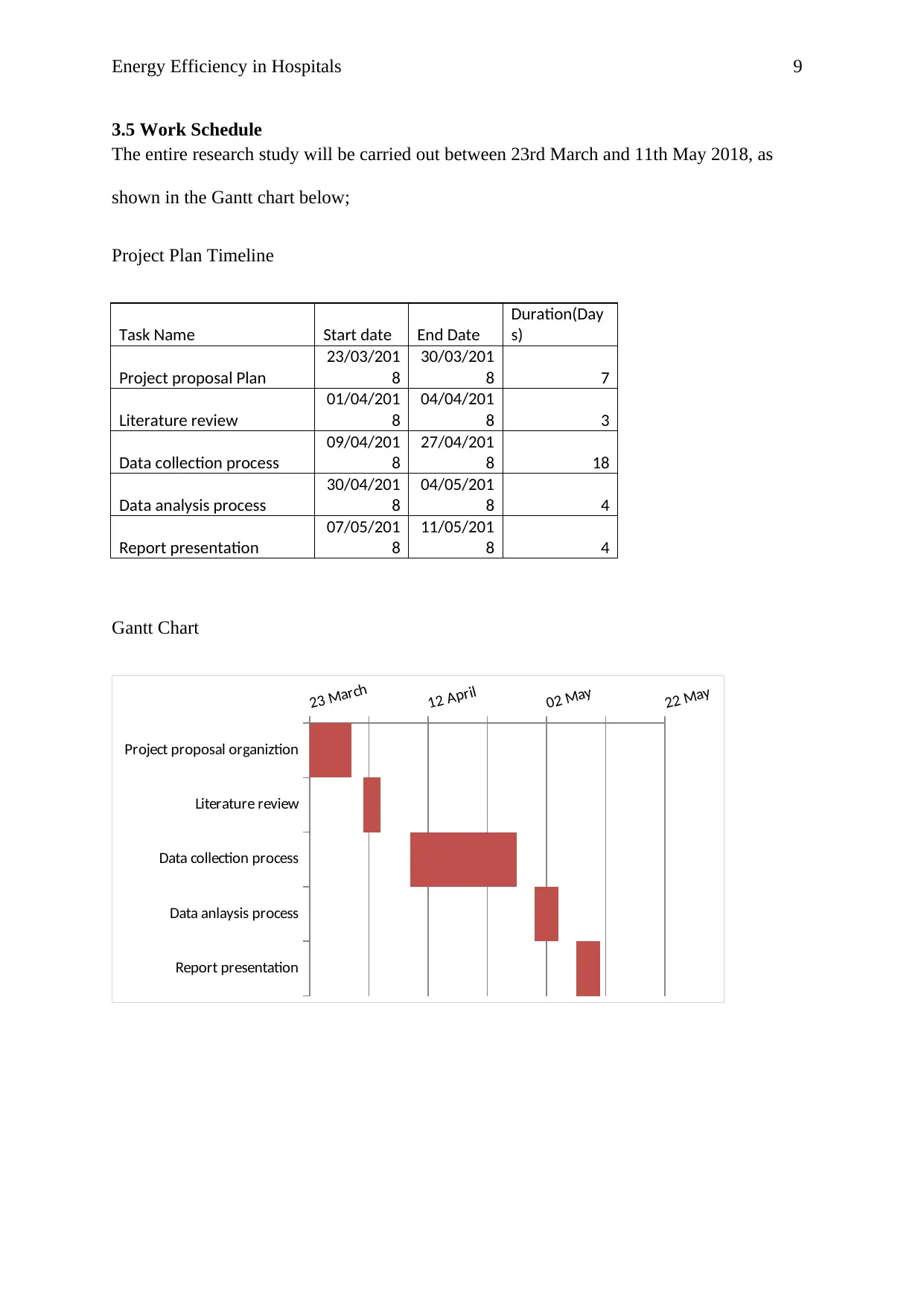
Energy Efficiency in Hospitals 9
3.5 Work Schedule
The entire research study will be carried out between 23rd March and 11th May 2018, as
shown in the Gantt chart below;
Project Plan Timeline
Task Name Start date End Date
Duration(Day
s)
Project proposal Plan
23/03/201
8
30/03/201
8 7
Literature review
01/04/201
8
04/04/201
8 3
Data collection process
09/04/201
8
27/04/201
8 18
Data analysis process
30/04/201
8
04/05/201
8 4
Report presentation
07/05/201
8
11/05/201
8 4
Gantt Chart
Project proposal organiztion
Literature review
Data collection process
Data anlaysis process
Report presentation
23 March
12 April
02 May
22 May
3.5 Work Schedule
The entire research study will be carried out between 23rd March and 11th May 2018, as
shown in the Gantt chart below;
Project Plan Timeline
Task Name Start date End Date
Duration(Day
s)
Project proposal Plan
23/03/201
8
30/03/201
8 7
Literature review
01/04/201
8
04/04/201
8 3
Data collection process
09/04/201
8
27/04/201
8 18
Data analysis process
30/04/201
8
04/05/201
8 4
Report presentation
07/05/201
8
11/05/201
8 4
Gantt Chart
Project proposal organiztion
Literature review
Data collection process
Data anlaysis process
Report presentation
23 March
12 April
02 May
22 May
⊘ This is a preview!⊘
Do you want full access?
Subscribe today to unlock all pages.

Trusted by 1+ million students worldwide

Energy Efficiency in Hospitals 10
References
Ascione, F., Bianco, N., De Masi, R. F., De Rossi, F., De Stasio, C., & Vanoli, G. P. (2016).
Energy audit of health care facilities: dynamic simulation of energy performances and
energy-oriented refurbishment of system and equipment for microclimatic
control. American Journal of Engineering and Applied Sciences, 9(4), 814-834.
Charmaz, K. (2014). Constructing grounded theory. Sage.
Giridharan, R., Lomas, K. J., Short, C. A., & Fair, A. J. (2013). Performance of hospital
spaces in summer: A case study of a ‘Nucleus’-type hospital in the UK
Midlands. Energy and Buildings, 66, 315-328.
Irvine, A., Drew, P., & Sainsbury, R. (2013). ‘Am I not answering your questions
properly?’Clarification, adequacy and responsiveness in semi-structured telephone
and face-to-face interviews. Qualitative Research, 13(1), 87-106.
Rajagopalan, P., & Elkadi, H. (2014). Energy performance of medium-sized healthcare
buildings in Victoria, Australia-A case study. Journal of healthcare engineering, 5(2),
247-260.
Saidur, R., Atabani, A. E., & Mekhilef, S. (2011). A review on electrical and thermal energy
for industries. Renewable and Sustainable Energy Reviews, 15(4), 2073-2086.
Sharon Licqurish, R. N., & Carmel Seibold, R. N. (2011). Applying a contemporary
grounded theory methodology. Nurse Researcher (through 2013), 18(4), 11.
Short, C. A., Cook, M., Cropper, P. C., & Al-Maiyah, S. (2010). Low energy refurbishment
References
Ascione, F., Bianco, N., De Masi, R. F., De Rossi, F., De Stasio, C., & Vanoli, G. P. (2016).
Energy audit of health care facilities: dynamic simulation of energy performances and
energy-oriented refurbishment of system and equipment for microclimatic
control. American Journal of Engineering and Applied Sciences, 9(4), 814-834.
Charmaz, K. (2014). Constructing grounded theory. Sage.
Giridharan, R., Lomas, K. J., Short, C. A., & Fair, A. J. (2013). Performance of hospital
spaces in summer: A case study of a ‘Nucleus’-type hospital in the UK
Midlands. Energy and Buildings, 66, 315-328.
Irvine, A., Drew, P., & Sainsbury, R. (2013). ‘Am I not answering your questions
properly?’Clarification, adequacy and responsiveness in semi-structured telephone
and face-to-face interviews. Qualitative Research, 13(1), 87-106.
Rajagopalan, P., & Elkadi, H. (2014). Energy performance of medium-sized healthcare
buildings in Victoria, Australia-A case study. Journal of healthcare engineering, 5(2),
247-260.
Saidur, R., Atabani, A. E., & Mekhilef, S. (2011). A review on electrical and thermal energy
for industries. Renewable and Sustainable Energy Reviews, 15(4), 2073-2086.
Sharon Licqurish, R. N., & Carmel Seibold, R. N. (2011). Applying a contemporary
grounded theory methodology. Nurse Researcher (through 2013), 18(4), 11.
Short, C. A., Cook, M., Cropper, P. C., & Al-Maiyah, S. (2010). Low energy refurbishment
Paraphrase This Document
Need a fresh take? Get an instant paraphrase of this document with our AI Paraphraser
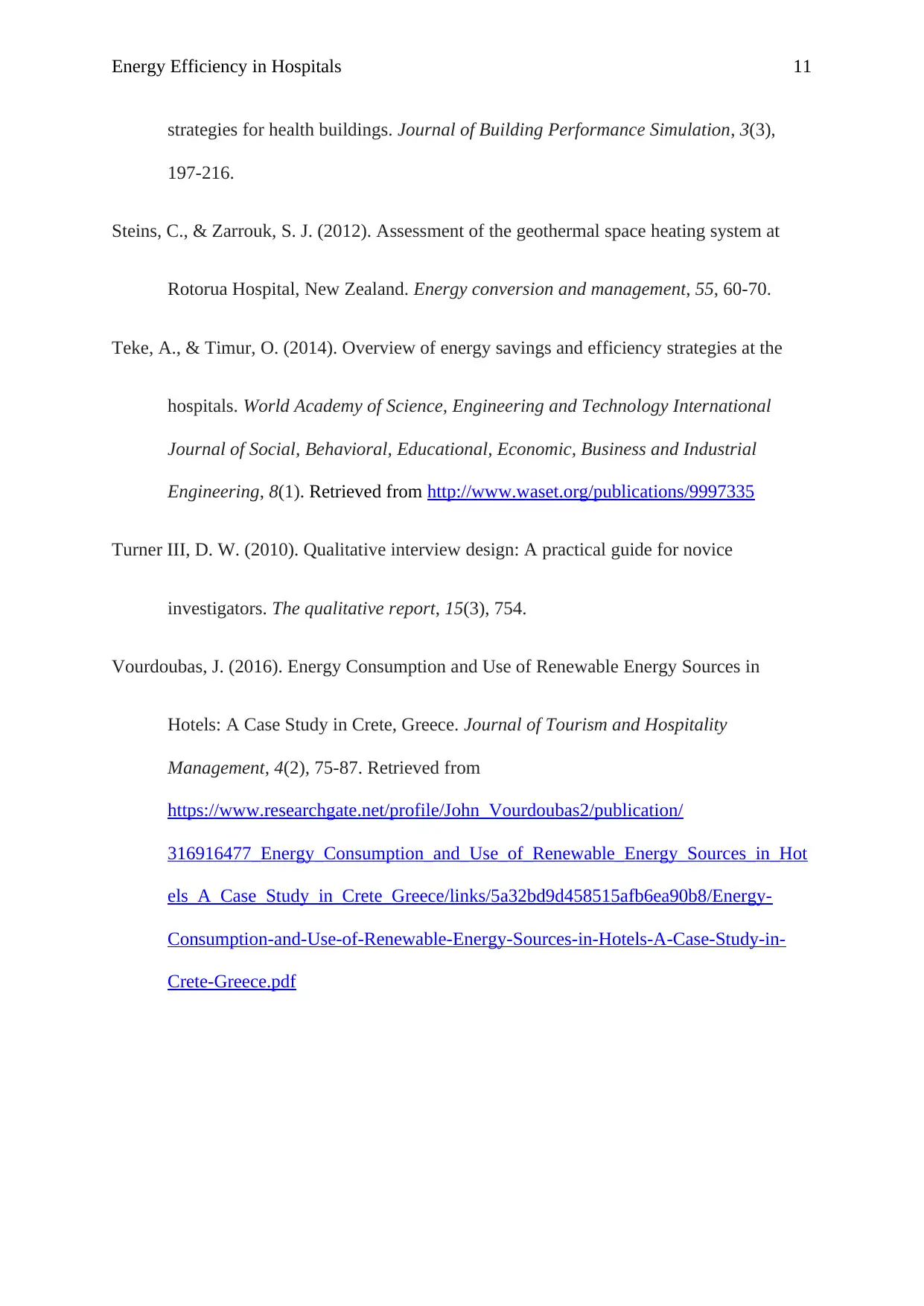
Energy Efficiency in Hospitals 11
strategies for health buildings. Journal of Building Performance Simulation, 3(3),
197-216.
Steins, C., & Zarrouk, S. J. (2012). Assessment of the geothermal space heating system at
Rotorua Hospital, New Zealand. Energy conversion and management, 55, 60-70.
Teke, A., & Timur, O. (2014). Overview of energy savings and efficiency strategies at the
hospitals. World Academy of Science, Engineering and Technology International
Journal of Social, Behavioral, Educational, Economic, Business and Industrial
Engineering, 8(1). Retrieved from http://www.waset.org/publications/9997335
Turner III, D. W. (2010). Qualitative interview design: A practical guide for novice
investigators. The qualitative report, 15(3), 754.
Vourdoubas, J. (2016). Energy Consumption and Use of Renewable Energy Sources in
Hotels: A Case Study in Crete, Greece. Journal of Tourism and Hospitality
Management, 4(2), 75-87. Retrieved from
https://www.researchgate.net/profile/John_Vourdoubas2/publication/
316916477_Energy_Consumption_and_Use_of_Renewable_Energy_Sources_in_Hot
els_A_Case_Study_in_Crete_Greece/links/5a32bd9d458515afb6ea90b8/Energy-
Consumption-and-Use-of-Renewable-Energy-Sources-in-Hotels-A-Case-Study-in-
Crete-Greece.pdf
strategies for health buildings. Journal of Building Performance Simulation, 3(3),
197-216.
Steins, C., & Zarrouk, S. J. (2012). Assessment of the geothermal space heating system at
Rotorua Hospital, New Zealand. Energy conversion and management, 55, 60-70.
Teke, A., & Timur, O. (2014). Overview of energy savings and efficiency strategies at the
hospitals. World Academy of Science, Engineering and Technology International
Journal of Social, Behavioral, Educational, Economic, Business and Industrial
Engineering, 8(1). Retrieved from http://www.waset.org/publications/9997335
Turner III, D. W. (2010). Qualitative interview design: A practical guide for novice
investigators. The qualitative report, 15(3), 754.
Vourdoubas, J. (2016). Energy Consumption and Use of Renewable Energy Sources in
Hotels: A Case Study in Crete, Greece. Journal of Tourism and Hospitality
Management, 4(2), 75-87. Retrieved from
https://www.researchgate.net/profile/John_Vourdoubas2/publication/
316916477_Energy_Consumption_and_Use_of_Renewable_Energy_Sources_in_Hot
els_A_Case_Study_in_Crete_Greece/links/5a32bd9d458515afb6ea90b8/Energy-
Consumption-and-Use-of-Renewable-Energy-Sources-in-Hotels-A-Case-Study-in-
Crete-Greece.pdf
1 out of 11
Related Documents
Your All-in-One AI-Powered Toolkit for Academic Success.
+13062052269
info@desklib.com
Available 24*7 on WhatsApp / Email
![[object Object]](/_next/static/media/star-bottom.7253800d.svg)
Unlock your academic potential
Copyright © 2020–2025 A2Z Services. All Rights Reserved. Developed and managed by ZUCOL.




